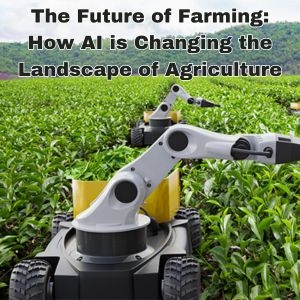The Future of Farming: How AI is Changing the Landscape of AgriculturePosted by Archi Jain on September 20th, 2023  Introduction to the Future of FarmingThe future of farming is here and it's leveraging advancements in Artificial Intelligence (AI), data science, automation, robotics, and drones to revolutionize agriculture. From yield and quality improvement to environment conservation, AI is changing the face of farming. As you can imagine, the opportunities presented by AI for the agricultural industry are immense. By using data science to inform decision making, farmers can now gain insights into their land that weren't previously available. This allows them to maximize yield and create a more efficient production process. In addition, automation allows farming operations to reduce labor costs by using intelligent machines for tedious tasks such as crop planting or weeding. Robotics and drones also provide a more cost effective solution for monitoring crops by providing real time images of a field that can be used to identify weeds or pests. Not only that but they can also act as automated sprayers in order to fight off insects with greater accuracy than traditional methods. Precision farming is another area where AI is being applied with all this newfound data and technology at hand. By utilizing advanced satellite imagery, sensors and geographical information systems (GIS), farmers are able to better monitor soil health and optimize resources such as water or fertilizer usage on an acre by acre basis thereby reducing waste while increasing yields at the same time. How AI is Changing the LandscapeAI has had a profound effect on the agricultural industry, allowing us to optimize crop growth, automate farming activities, and improve climate adaptation. By harnessing the power of data science and machine learning, we can now use AI to revolutionize the way we work with nature to create efficient farming solutions. At its core, AI involves using computers to measure and learn from existing data points in order to identify patterns and insights that can help farmers make decisions. With AIdriven analysis of big data sets about soil conditions, weather patterns, plant health and other factors that affect crop growth, farmers can better predict which crops will yield successful harvests and create better yields for their farms. AI is also being used to automate many of the manual tasks associated with running a farm. In addition to optimizing production processes like harvesting and planting crops, AI systems can be utilized for other tasks such as managing irrigation systems or interpreting images taken by drones or satellites for cultivating more successful crops. This automation not only increases efficiency but also reduces costs associated with labor intensive farming activities – a win-win situation for both farmers and consumers alike! And finally, AI is playing an increasingly important role in helping farmers adapt to changing climates by providing real time data about soil moisture levels or early warning signs for storms or floods. With this insight, farmers can make more informed decisions about when to plant or harvest crops as well as adjust their plans accordingly if weather conditions become too extreme. The Benefits of AI in Agriculture
Data Collection and AnalysisNutrition and food production are among the most pressing global issues of today. As such, it is essential that we explore how technology can help farmers in their quest to grow more food efficiently and sustainably. AI, with its ability to process massive amounts of data quickly and accurately, is one of the most important advances in modern agriculture. AIdriven data collection and analysis have the potential to revolutionize farming as we know it. Data Collection: Automation is becoming increasingly common in modern agriculture with machines being used for various tasks from planting seeds, harvesting crops, to collecting data about weather and soil conditions. All this information can be collected automatically by sensors connected through the internet of things (IoT). This automated data collection helps farmers track trends over time and enables them to make decisions based on real time information. AIdriven Crop Monitoring: AIdriven crop monitoring can be used to analyze images from drones or satellites and provide an accurate reading of crop growth and health. This allows farmers to more accurately assess the quality of their soil, identify pests or diseases that may affect their crops, and spot areas where plants are not getting enough nutrients for optimal growth. Machine Learning: Machine learning algorithms can be used to predict best practices for maximizing yield, mitigating risks associated with pests or disease outbreaks, and making decisions regarding inputs like irrigation or fertilization. By gathering data from multiple sources like weather tracking systems as well as soil moisture sensors, these algorithms can provide insights into how best to optimize yields while also helping farmers save money by avoiding unnecessary inputs or resources. Autonomous Systems for Pest Control and Plant CareAI technology has revolutionized many industries, and agriculture is no exception. The development of autonomous systems and robotics has enabled farmers to increase their efficiency by automating tedious tasks such as pest management, crop protection, and plant care. As a result, data science solutions, precision agriculture, and AI applications in farming are becoming more commonplace in the agricultural industry. As a farmer, you are likely aware of the importance of pest management in order to protect crops from disease and infestations. Autonomous systems are designed to detect pests using sensors or high resolution cameras throughout your fields. This data can then be used to inform decisions regarding pesticide application or other management techniques. Similarly, with robot assisted crop protection, autonomous systems rely on cameras for monitoring weed growth patterns and can be programmed to provide targeted treatments aimed at eliminating weeds without impacting the health of nearby crops. In addition to pest control and crop protection, AI technologies can also help with plant care by measuring soil quality and humidity levels within your fields. This information can be used to determine when additional fertilizers or other treatments are needed in order to maintain optimal growth conditions. By integrating data science solutions into your operations, you can improve yields while reducing costs associated with traditional farming practices. From automated weather monitoring systems for predicting harvest times to AI algorithms that help eliminate waste while optimizing yields, smart technology is transforming how farmers manage their operations. The combination of robotics, data science solutions, precision agriculture, and AI applications is revolutionizing farming practices worldwide – helping create a future that’s both sustainable and efficient. Smart Irrigation TechniquesOne of the main benefits of incorporating AI into agriculture is automation. AIdriven systems can be used to predict when and where water needs to be delivered to maximize crop success while minimizing water usage. Automation also allows farmers to accurately track and measure soil moisture levels as well as nutrient levels. This ensures not only that crops are optimally watered but also that they receive just the right amount of nutrients they need for optimal growth. Another important advancement that smart irrigation techniques provide is the ability to monitor drought conditions more efficiently. With a data driven system in place, it’s possible for farmers to control how much water they use by enabling them to adjust their irrigation schedules according to local climate changes or seasonal trends. By only using the necessary amount of water needed for crop growth in drought conditions, farmers can prevent unnecessary waste while also maintaining profitable yields. In addition to automation and drought monitoring, smart irrigation techniques give farmers a greater capacity for groundwater monitoring which allows them to sustainably manage their resources over time. Low flow systems like subsurface drip irrigation can help farmers reduce runoff and conserve valuable groundwater resources with minimal intrusion on their daily operations – all thanks to sensors and advanced algorithms which allow them to measure specific soil parameters like temperature, moisture content, and pH level in order to best serve their crops’ needs. Recycling Nutrients and Rethinking Waste Management with AI TechnologyUsing data science paired with AI technology, farms are able to automate many processes including the tracking of nutrients from crop production all the way through to soil replenishment. This automation allows for more accurate measurements of nutrient levels within the soil which can help ensure that resources are not wasted needlessly. Furthermore, this data driven approach enables smarter resource allocation across different farm systems so as to maximize efficiency and productivity. AI can also be utilized to analyze patterns in historical data related to natural resources such as rain and temperature, allowing farmers to be more prepared for forthcoming weather conditions. This information can help prepare farmers for periods of droughts or heavy rainfall in order to increase crop yield when needed most. Additionally, AIdriven solutions such as websites where farmers can list available sources of foods helps facilitate better food sustainability by connecting surplus produce with those who may need it most. We’re only just beginning to scratch the surface on what AI technology can bring to farming practices today. By leveraging advances in technology like AI and data science, we’re able to rethink how we manage our resources with more precision than ever before – creating a better world for everyone involved in this industry as well as consumers further down the line who benefit from improved yield and quality of crops produced using efficient methods of recycling nutrients. You can also read:innomatics reviewsinnomaticsinnomatics data science reviewsinnomatics data science course reviewsbesant technologies reviewsbesant technologiesbesant technologies data sciencebesant technologies data science reviewsbesant technologies placement newsLike it? Share it!More by this author |


